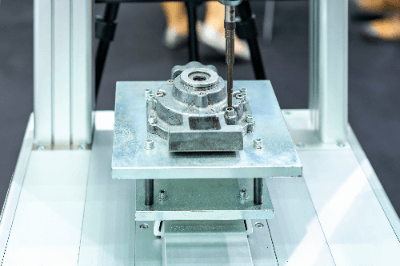What Is a Robotic Screwdriver?

A Robotic Screwdriver is a robot that automatically performs screw fastening tasks that were previously performed by a worker.
Robotic Screwdrivers automate screw fastening operations and increase manufacturing efficiency. In addition, the robot’s error detection function detects missing products caused by dropped screws or floating screws due to faulty screw work, enabling stable production.
There are many different types of screw fastening robot systems, including multi-axis robots, SCARA robots, parallel link robots, Cartesian coordinate-type screw fastening robots, dual-arm screw fastening robots, and small table-top types.
Applications of Robotic Screwdrivers
Robotic Screwdrivers are often used in production lines for mass-produced products. Robotic Screwdrivers are used for fastening screws in areas where human labor is inefficient. For example, the robot is useful for fastening machine cases, where many screws are used, or where the screw size is too small to be fastened by hand.
The robot can handle many types of screws, such as pot screws, countersunk screws, truss screws, Semmes screws, and Y recesses. It can also be adapted to hex bolts and hex nuts. A wide range of screw materials are available, including steel materials, aluminum alloys, and resin.
However, there are some areas where it is difficult to utilize Robotic Screwdriver. For example, when there is an obstacle nearby, on an inside surface, or when used in a deep hole. Therefore, it is important to select a model according to the application.
Principle of Robotic Screwdriver
A Robotic Screwdriver mainly consists of a robot, an electric screwdriver, a controller, and a screw feeder.
1. Robot
The robot is a device used to precisely position the electric screwdriver to the part to be fastened. There are various types of robots used for Robotic Screwdriver. SCARA Robots with multi-joints for easy movement and Cartesian Robots are often used.
2. Electric Screwdriver
This is attached to the end of the arm of the robot.
3. Controller
The robot’s position information and the electric screwdriver’s torque, rotation angle, and other information are controlled by the controller. The screw feeder stores screws and supplies them to the Robotic Screwdriver for efficient fastening work.
Other Information on the Robotic Screwdriver
1. Functions of the Robotic Screwdriver
The Robotic Screwdriver has a variety of additional functions to perform the screw fastening operation automatically. First, the controller connected to the electric screwdriver has functions such as torque and rotation angle management, torque and rotation angle control, screw fastening patterns, and good/fail judgment.
The tightening torque and rotation angle are very important information for automating screw fastening operations. Some models are also equipped with sensors to detect abnormalities or defects in the screw parts themselves, such as a screw hole being crushed or jammed.
2. Coefficient of Friction Important for Screw Fastening
The key to proper screw fastening is to obtain the required axial force. Axial force is the force that holds the screw in place and is generated by the elastic force of the screw as it is pulled back. In normal screw fastening operations, it is not possible to directly check how much axial force was generated for each screw. Therefore, as substitute characteristics, the tightening torque and rotation angle are monitored.
The most common and widely used parameter is the tightening torque. Tightening torque is sometimes specified in assembly drawings of DIY products for the general public. However, proper axial force can only be obtained by tightening a screw with the specified tightening torque if the frictional force generated when fastening the screw is within the expected range.
Specifically, it is the coefficient of friction between the contact surfaces of the screw’s peaks and troughs, and between the head of the screw and the surface on which the screw is seated. If the coefficients of friction in the two areas related to the screw are higher than the expected range, sufficient axial force cannot be obtained even when working with the appropriate tightening torque.
Conversely, if the coefficient of friction is lower than expected, the axial force generated is too high and the screw may break or spin out. It is important to recognize that the tightening torque and rotation angle are only surrogate values for screw fastening, whether done manually or robotically, and that the correct axial force cannot be obtained if the coefficient of friction is not within the assumed range.